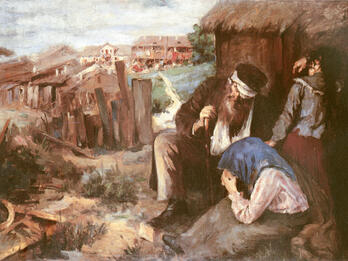Jankiel’s Concert
Maurycy Trębacz
1900

Creator Bio
Maurycy Trębacz
Born in Warsaw to a house painter, Maurycy (Mojżesz) Trębacz grew up with an interest in painting. With scholarships and the support of patrons, Trębacz studied in Warsaw, Kraków, and Munich, earning awards and accolades for his portraits and landscapes. Working initially in the Polish Romantic-national tradition, he later evolved toward Impressionism. Thematically, he focused on landscape, portraiture, and a mix of biblical and Polish romantic subjects but began to produce contemporary, politically informed depictions of Jewish life and political woe at the turn of the century as he developed Zionist sympathies. Receiving antisemitic criticism for these, Trębacz was motivated to organize Warsaw’s first Jewish art exhibition (1911). He ran a painting school in Łódź from 1918 until it was closed with the Nazi invasion in 1939. He died in the Łódź ghetto.
You may also like

The Wandering Jew

Herzl Observing the Rhine from the Balcony of Hotel Les Trois Rois during the Fifth Zionist Congress in 1901 in Basel

Die Erschaffung des Menschen (The Creation of Man)

The Hand of Man

A Difficult Passage in the Talmud


